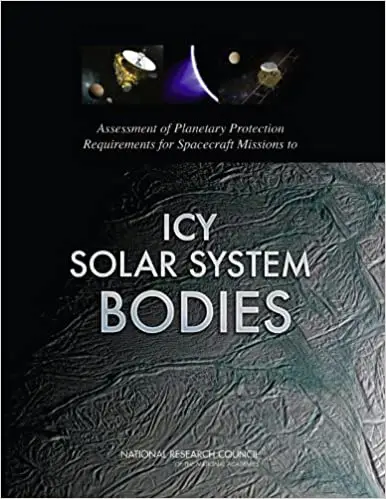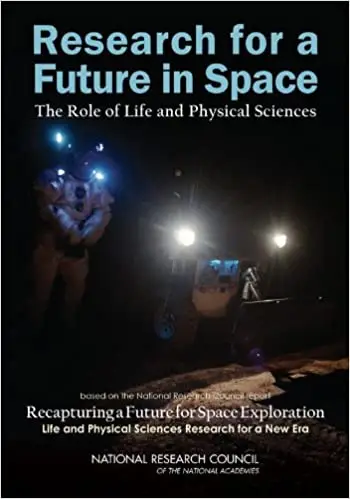Rapports du National Research Council
Page 1 sur 1
Assessment of planetary protection requirements for spacecraft missions to icy solar system bodies (2012)

https://uptobox.com/4grns7x2co3v (pdf - 5,8 Mo)
NASA's exploration of planets and satellites during the past 50 years has led to the discovery of traces of water ice throughout the solar system and prospects for large liquid water reservoirs beneath the frozen ICE shells of multiple satellites of the giant planets of the outer solar system. During the coming decades, NASA and other space agencies will send flybys, orbiters, subsurface probes, and, possibly, landers to these distant worlds in order to explore their geologic and chemical context. Because of their potential to harbor alien life, NASA will select missions that target the most habitable outer solar system objects. This strategy poses formidable challenges for mission planners who must balance the opportunity for exploration with the risk of contamination by Earth's microbes, which could confuse the interpretation of data obtained from these objects.
The 2000 NRC report Preventing the Forward Contamination of Europa provided a criterion that was adopted with prior recommendations from the Committee on Space Research of the International Council for Science. This current NRC report revisits and extends the findings and recommendations of the 2000 Europa report in light of recent advances in planetary and life sciences and, among other tasks, assesses the risk of contamination of icy bodies in the solar system.
Table of Contents
Front Matter
Summary
1 Current Status of Planetary Protection Policies for Icy Bodies
2 Binary Decision Trees
3 Hierarchical Decisions for Planetary Protection
4 A Geophysical Perspective and Inventory of Habitable Environments on Icy Bodies
5 Microbial Metabolism and Physiology
6 Necessary Research
Appendixes
Appendix A: Letter Requesting This Study
Appendix B: Current and Prospective Missions to Icy Bodies of Astrobiological Interest
Appendix C: Event Sequence Diagram for the Determination of Planetary Protection Measures for Missions to Icy Bodies
Appendix D: Committee and Staff Biographical Information
Appendix E: Glossary and Abbreviations

https://uptobox.com/4grns7x2co3v (pdf - 5,8 Mo)
NASA's exploration of planets and satellites during the past 50 years has led to the discovery of traces of water ice throughout the solar system and prospects for large liquid water reservoirs beneath the frozen ICE shells of multiple satellites of the giant planets of the outer solar system. During the coming decades, NASA and other space agencies will send flybys, orbiters, subsurface probes, and, possibly, landers to these distant worlds in order to explore their geologic and chemical context. Because of their potential to harbor alien life, NASA will select missions that target the most habitable outer solar system objects. This strategy poses formidable challenges for mission planners who must balance the opportunity for exploration with the risk of contamination by Earth's microbes, which could confuse the interpretation of data obtained from these objects.
The 2000 NRC report Preventing the Forward Contamination of Europa provided a criterion that was adopted with prior recommendations from the Committee on Space Research of the International Council for Science. This current NRC report revisits and extends the findings and recommendations of the 2000 Europa report in light of recent advances in planetary and life sciences and, among other tasks, assesses the risk of contamination of icy bodies in the solar system.
Table of Contents
Front Matter
Summary
1 Current Status of Planetary Protection Policies for Icy Bodies
2 Binary Decision Trees
3 Hierarchical Decisions for Planetary Protection
4 A Geophysical Perspective and Inventory of Habitable Environments on Icy Bodies
5 Microbial Metabolism and Physiology
6 Necessary Research
Appendixes
Appendix A: Letter Requesting This Study
Appendix B: Current and Prospective Missions to Icy Bodies of Astrobiological Interest
Appendix C: Event Sequence Diagram for the Determination of Planetary Protection Measures for Missions to Icy Bodies
Appendix D: Committee and Staff Biographical Information
Appendix E: Glossary and Abbreviations
_________________
Le désespoir est une forme supérieure de la critique. (Léo Ferré)

David L.- Modérateur

- Messages : 34773
Inscrit le : 16/08/2009
Age : 51
Localisation : Troisième planète
Research for a future in space - The role of life and physical sciences (NRC, 2012)

https://uptobox.com/akjib7f5gebf (pdf - 11,3 Mo)
During its more than 50-year history, NASA's success in human space exploration has depended on the agency's ability to effectively address a wide range of biomedical, engineering, physical sciences, and related obstacles. This achievement is made possible by NASA's strong and productive commitments to life and physical sciences research for human space exploration, and by its use of human space exploration infrastructures for scientific discovery.
Research for a Future in Space: The Role of Life and Physical Sciences explains how unique characteristics of the space environment can be used to address complex problems in the life and physical sciences. This booklet also helps deliver both new knowledge and practical benefits for humankind as it embarks on a new era of space exploration.
Research for a Future in Space: The Role of Life and Physical Sciences is based on the in depth report, Recapturing a Future for Space Exploration: Life and Physical Sciences Research for a New Era. To learn more about the future of space exploration, visit our catalog page and download this report for free.

https://uptobox.com/akjib7f5gebf (pdf - 11,3 Mo)
During its more than 50-year history, NASA's success in human space exploration has depended on the agency's ability to effectively address a wide range of biomedical, engineering, physical sciences, and related obstacles. This achievement is made possible by NASA's strong and productive commitments to life and physical sciences research for human space exploration, and by its use of human space exploration infrastructures for scientific discovery.
Research for a Future in Space: The Role of Life and Physical Sciences explains how unique characteristics of the space environment can be used to address complex problems in the life and physical sciences. This booklet also helps deliver both new knowledge and practical benefits for humankind as it embarks on a new era of space exploration.
Research for a Future in Space: The Role of Life and Physical Sciences is based on the in depth report, Recapturing a Future for Space Exploration: Life and Physical Sciences Research for a New Era. To learn more about the future of space exploration, visit our catalog page and download this report for free.
_________________
Le désespoir est une forme supérieure de la critique. (Léo Ferré)

David L.- Modérateur

- Messages : 34773
Inscrit le : 16/08/2009
Age : 51
Localisation : Troisième planète
 Sujets similaires
Sujets similaires» [USA] Rapports et auditions
» Rapports des vols des équipages 10 & 11
» Armstrong Flight Research Center
» Terminator au Ames Research Center
» A télécharger: Mercury Project, Research & Development
» Rapports des vols des équipages 10 & 11
» Armstrong Flight Research Center
» Terminator au Ames Research Center
» A télécharger: Mercury Project, Research & Development
Page 1 sur 1
Permission de ce forum:
Vous ne pouvez pas répondre aux sujets dans ce forum
 Portail
Portail




 Ven 15 Mai 2020 - 16:49
Ven 15 Mai 2020 - 16:49
